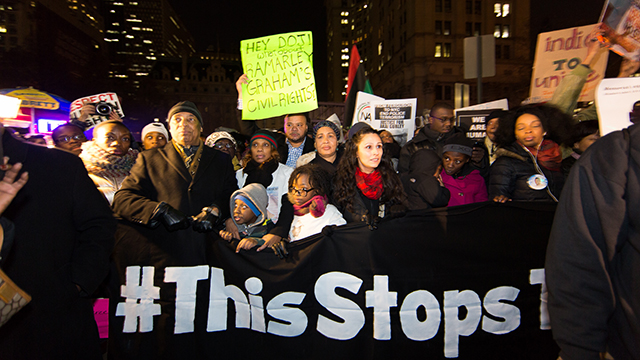This post first appeared at The Brennan Center for Justice.

(Photo: EventPhotosNYC/flickr CC 2.0)
2014 was a year, as many are, of modest steps forward and a few steps back in criminal justice reform. But the national focus on flaws in our criminal justice system could lead to stronger reforms in 2015.
The year proved to be a victory for those advocating for changes in drug laws. In November, voters in Oregon, Alaska and Washington DC voted to legalize marijuana, while New York City police officers will issue summonses in lieu of arrest for possession of small amounts of marijuana — a marked shift from the nation’s mood in June of 1971 when President Richard Nixon officially declared a “war on drugs” and stated that drug abuse is “public enemy number one.”
The Justice Department took a big step forward this year by reforming overly harsh sentencing laws. At Attorney General Eric Holder’s request, the US Sentencing Commission amended federal sentencing guidelines to reduce the average sentence length for most drug trafficking offenders by 18 percent. Additionally, Holder continued to advocate for “Smart on Crime” policies, which he describes as “a targeted effort to enhance the way we charge, sentence and release individuals in order to end this country’s overreliance on incarceration and to promote efforts that give people the tools they need to return to their communities and lead better and more productive lives.”
2014 also saw legislative efforts to roll back America’s punitive criminal justice policies. Sen. Cory Booker (D-NJ) and Sen. Rand Paul (R-KY) introduced the REDEEM Act, which aims to keep juveniles out of the adult criminal justice system and incentivizes states to make it easier for formerly incarcerated adults to have their criminal records sealed. Sen. Dick Durbin’s (D-IL) and Sen. Mike Lee’s (R-UT) also introduced legislation, the Smarter Sentencing Act, which received wide sponsorship in the Senate. The bill reduces some mandatory minimum sentences and allows individuals sentenced under the old crack cocaine – powder cocaine laws to petition for a sentence reduction based on new provisions in the 2010 Fair Sentencing Act.
Conservatives also continued to champion the need for reform this year. A panel at the Conservative Political Action Conference (CPAC) addressed how to recalibrate the American criminal justice system so that it is focused more on rehabilitation than simple retribution. Panel members included the director of the American Conservative Union’s Center for Criminal Justice Reform Pat Nolan, president of Americans for Tax Reform Grover Norquist, Texas Gov. Rick Perry (a possible GOP presidential candidate) and former New York Police Commissioner Bernard Kerik.
There was also a tremendous movement in the states to reduce the number of people who are incarcerated. Currently, more than 86 percent of prisoners in the US are in state facilities. Idaho passed legislation that, among other things, restructures parole to prioritize prison space for violent and high-risk offenders. Mississippi enacted a package of reforms aimed at refocusing prison space on violent and career criminals in addition to providing more resources to probation and parole services. In California, a state that is struggling to control its inmate population, voters authorized Proposition 47 which retroactively classifies six low-level felony offenses as misdemeanors. San Francisco, Washington DC, and states such as Delaware, Illinois, Nebraska and New Jersey also adopted ban the box policies which removed questions related to criminal records from employment applications.
Also promising this year, the US executed the fewest number of people under the death penalty in two decades. Thirty-five inmates were executed this year down from 98 executions in 1999. The majority of those executions, or 80 percent, were carried out in only three states: Florida, Texas and Missouri. Additionally, seven death row inmates were exonerated this year, the most recent on December 9th in Ohio.
There were also other signs that people are waking up to our nation’s addiction to mass incarceration, including a whopping $50 million grant to the American Civil Liberties Union’s political arm to reduce incarceration by 50 percent over an eight year span. The National Academy of Sciences also issued a 464-page report this year urging the nation to revise criminal justice policies to significantly reduce imprisonment rates. The Brookings Institution’s Hamilton Project also shed light on the country’s $80 billion a year in direct corrections expenses in a recent report. And, more than a million people viewed the VlogBrothers’ four-minute video focusing on how the war on crime is failed policy and that, “It’s cruel, it’s shortsighted, and to continue this policy of mass incarceration would be foolish. We’re living inside of a massive $75 billion per year failed experiment.”
Sadly, despite well-intentioned efforts made toward improving how we treat those who come into contact with the criminal justice system, most will remember 2014 for the cases of Eric Garner and Michael Brown. 2014 will inevitably be written into the history books as the year two grand juries in two separate cases in two different states voted not to indict white police officers who used what many believed was excessive force exerted upon unarmed African-American civilians that resulted in their deaths. It will forever be known for its hashtags such as #ICantBreathe, #blacklivesmatter, #HandsUpDon’tShoot and #justiceformikebrown.
Since these lack of indictments were announced, less than a month apart, legislators have introduced grand jury reform legislation and President Obama appointed a Task Force on 21st Century Policing. The White House blog announcing the task force states that it “will examine how to strengthen public trust and foster strong relationships between local law enforcement and the communities that they protect, while also promoting effective crime reduction.” While the Task Force was in the works before these grand jury decisions were announced, the group’s recommendations will be carefully followed by many Americans in 2015. And, earlier this summer, after the photographs and videos of police in riot gear as a response to violence in Ferguson, Missouri, were tweeted, posted and carried by national media, President Obama directed a review of federal programs and funding that allow state and local law-enforcement agencies to acquire surplus military equipment.
It’s been a busy year for those working to improve the criminal justice system. The seeds sown for reform in 2014 have the potential for genuine change in 2015. With violent crime rates continuing a downward trend, communities reporting less fear of crime, major federal reviews of policing and grants programs, bipartisan legislation pending in Congress, and a 2016 presidential campaign about to kick into high gear, 2015 has the prospect of serving as an important year for those who wish to improve the fairness, efficiency and justice of America’s criminal justice system.
The views expressed in this post are the author’s alone, and presented here to offer a variety of perspectives to our readers.


